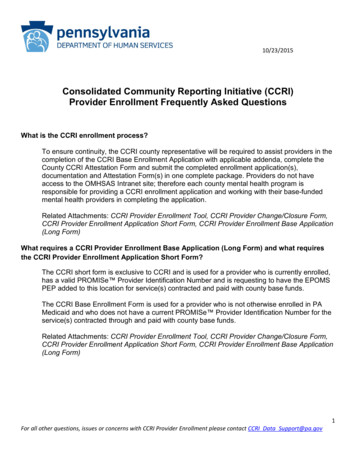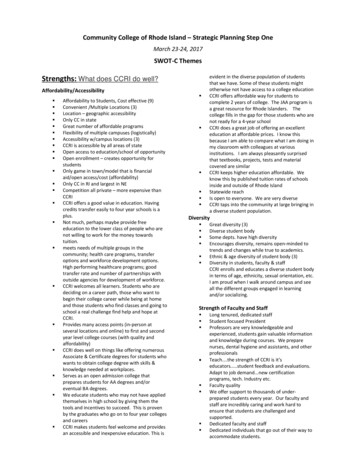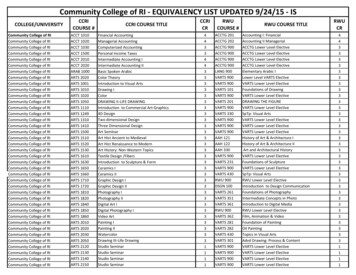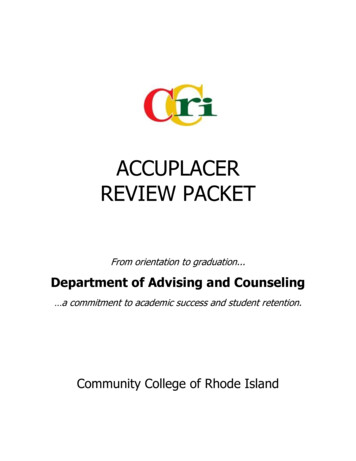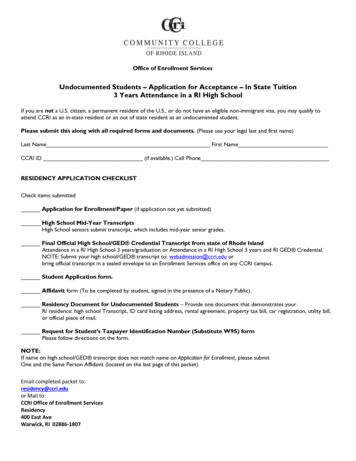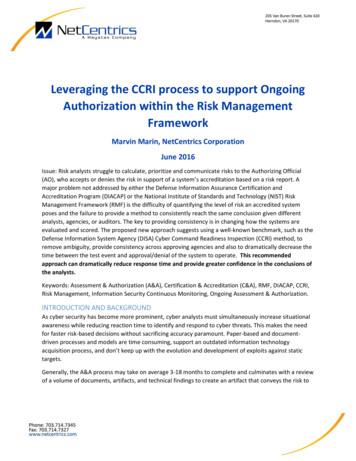
Transcription
Leveraging the CCRI process to support OngoingAuthorization within the Risk ManagementFrameworkMarvin Marin, NetCentrics CorporationJune 2016Issue: Risk analysts struggle to calculate, prioritize and communicate risks to the Authorizing Official(AO), who accepts or denies the risk in support of a system’s accreditation based on a risk report. Amajor problem not addressed by either the Defense Information Assurance Certification andAccreditation Program (DIACAP) or the National Institute of Standards and Technology (NIST) RiskManagement Framework (RMF) is the difficulty of quantifying the level of risk an accredited systemposes and the failure to provide a method to consistently reach the same conclusion given differentanalysts, agencies, or auditors. The key to providing consistency is in changing how the systems areevaluated and scored. The proposed new approach suggests using a well-known benchmark, such as theDefense Information System Agency (DISA) Cyber Command Readiness Inspection (CCRI) method, toremove ambiguity, provide consistency across approving agencies and also to dramatically decrease thetime between the test event and approval/denial of the system to operate. This recommendedapproach can dramatically reduce response time and provide greater confidence in the conclusions ofthe analysts.Keywords: Assessment & Authorization (A&A), Certification & Accreditation (C&A), RMF, DIACAP, CCRI,Risk Management, Information Security Continuous Monitoring, Ongoing Assessment & Authorization.INTRODUCTION AND BACKGROUNDAs cyber security has become more prominent, cyber analysts must simultaneously increase situationalawareness while reducing reaction time to identify and respond to cyber threats. This makes the needfor faster risk-based decisions without sacrificing accuracy paramount. Paper-based and documentdriven processes and models are time consuming, support an outdated information technologyacquisition process, and don’t keep up with the evolution and development of exploits against statictargets.Generally, the A&A process may take on average 3-18 months to complete and culminates with a reviewof a volume of documents, artifacts, and technical findings to create an artifact that conveys the risk to
2an AO so an accreditation decision can be made. The A&A process defined by the RMF process iscomprised of six phases (Figure 1) that document the information system, attributes (requirements,applicable security controls, etc.); technical and non-technical weaknesses, and a risk-based decision inorder to authorize.RMFThe overall RMF process is intended to be iterative so that as the cycle continues the individual stepscan build upon each other, act independently, or trigger functions and tasks in a different step (NIST800-37). For example, a security control that was documented as inherited from another service orprogram may be assessed as non-compliant requiring a change in how the control is documented, whichleads to an additional assessment to validate the control. Therefore, instead of a rigid linear process,RMF encourages flexibility and agility to meet mission requirements while providing a structuredframework that encourages mitigating risk of operation.Figure 1 Risk Management Framework
3In practice, navigating through the RMF process tends to be a tedious and time consuming exercise thatemphasizes documentation over control implementation and testing. The RMF process is notnecessarily a failure point; rather, some implementations of the framework put a higher emphasis onthe review of documents instead of the evaluation of technical security controls and the overall risks.While within the purview of the AO’s risk acceptance and decision making authority, this also makessharing security information across enclaves and organizations much more difficult. For example, someorganizations may perform a vulnerability scan and cursory review of documentation to determine if thesystem has met required security requirements. Other organizations may be more proactive and testevery asset against a required baseline such as the Security Technology Implementation Guide (STIG) orthe United States Government Configuration Baseline (USGCB) and then perform manual IndependentVerification and Validation (IV&V) on non-technical controls (e.g. physical and environmental controls).This disparity between how organizations implement the process is a major hindrance to sharingsecurity information and causes delays that could be rectified through the use of a consistent andrepeatable process.CCRIThe CCRI process is used to assess Department of Defense (DOD) systems against a known minimumsecurity baseline so that a system or network can resist a cyber-attack. The process combines theevaluation of technical and non-technical controls against established baselines and outputs a metricthat can be applied to every DOD service to determine if an assessed site meets the minimumrequirements to operate on the Department of Defense Information Network (DODIN). A failing scoredemonstrates that the site has a negative security posture and that US Cyber Command (USCC) mayterminate that site’s connection to the DODIN as it provides an unacceptable level of risk that shouldnot be shared with the entire defense community. Additional information about the CCRI process isavailable to personnel with a Common Access Card (CAC) by visiting the Defense Information SystemsAgency (DISA) website http://www.disa.mil.Proposed SolutionThe proposed solution is a model that focuses on the combination of the A&A and CCRI processes tosupport automated assessments. The use of the CCRI methodology to evaluate a system for technicaland non-technical weaknesses creates a consistent, repeatable and reliable metric. Additionally, if thescoring metric is agreed upon in advance (e.g., any score over 90%) an enterprise application such as aGovernance Risk Compliance (GRC) tool could automatically issue an Approval to Operate (ATO) letterwithout further human intervention (e.g. the AO). Finally, if a common metric is used across the FederalGovernment and/or DoD, reciprocity reviews could also be quickly completed with limited humanreview thereby assisting in the transition of the organization from the use of Static Authorization to anOngoing Authorization mode of operation. The solution increases consistency across agencies ororganizations, reduces response time, decreases time and labor cost to the Government, andsimplifies systems integration and data exchange, since risk will be assessed in the same way.
4While this paper focuses on the CCRI as the testing methodology to use, any testing methodology couldbe used to drive the same result. For example, the Marine Corps has experimented with “C&A in a day,”an Ongoing Authorization model, where an evaluated system is placed in a lab and multiple vulnerabilityscanning and penetration tools are used to evaluate weaknesses. Their GRC tool (RSA Archer) can thenaggregate the information, conduct a comparison between weaknesses and known upscale protectionmechanisms, (i.e., the security stack) and make a determination if the system meets the minimumcertifiable threshold. When successfully tested against a Program of Record (POR), the evaluation toprovide a simulated ATO took two days and found undisclosed faults by the vendor, whereas receivingan ATO letter through the commonly accepted practice would have taken more than three months.While the actual scoring metric is outside the scope of this document, a score of 90% or greater is usedas an example solely for this article and does not directly reflect what is required to pass a CCRI.Organizations are free to use whatever passing score they feel meets the criteria for their risk profilewith the understanding that reciprocity would require a passing score to be equal to or greater than thepassing score of the receiving organization. Organizations within the DoDIN would be encouraged touse the CCRI passing score as it reflects the most consistent metric available.The automation of security control testing is supported and encouraged under NIST SP 800-53A and theproposed model is simply stated, the substitution of the assessment of security controls, theauthorization process, and a focus on operationalizing the Monitor step by applying facets ofContinuous Diagnostics and Mitigation (CDM).We are proposing that the Assess, Authorize, and Monitor steps as depicted below in Figure 2 beadjusted to incorporate the CCRI process (Assess), CCRI score evaluated against AO approved metrics(Authorize) and a Plan of Action & Milestones (POA&M) (Monitor) be implemented. Figure 3 depictsthe proposed adjustments to the applicable phases or steps that may be implemented within the RMF.
5CategorizeFIPS 199SelectCNSSI 1253ImplementAssess800-53AAssess SecurityControlsAuthorizePreparePOA&MMonitorAssess controlsannuallyPackage to AOHighwatermarkSelect SecurityControlsSSPPrepare SARRiskdeterminationRemediationFigure 2 RMF PhasesAssessAuthorizeFull PASS ATO issued instantlyMonitorAssess controls annuallyPartial PASS Limited ATO &(possible) package reviewCCRI or CCRI-type assessmentRemediationFAIL DATO issued and packagereviewPrepare POA&MPOA&M Maintenance & CDMFigure 3 Proposed modifications to Assess, Authorize and MonitorThe Assess phase would be replaced with the CCRI to perform an assessment of the system or networksadherence to technical and non-technical security controls. The culmination of the CCRI will be a scorethat will take the place of the Security Assessment Report (SAR). The output of the CCRI test event willalso allow the operational teams to begin conducting remediation or mitigation actions and to prepareappropriate POA&Ms, if necessary.The Authorize phase would rely solely on the CCRI score and the grading criteria established by the AO.Figure 4 depicts an example of 3 systems undergoing an A&A process using the proposed solution. Inthe figure below, System A scored 95% which exceeds the minimum required CCRI Score (CS) of 90% tobe issued an automatic ATO. System B scored a CS of 85% which is not sufficient to be granted an
6automatic ATO but does exceed the level for which a Denial of Authorization to Operate (DATO) wouldautomatically be issued. In this case, System B could be turned over for a manual review process or anATO with Conditions (one year or less and potentially issued with stringent conditions) issued. System Cscored a CS of 75% and did not achieve a sufficient score to be granted an ATO with Conditions. In thiscase, System C could be turned over for a manual review process and/or a DATO issued.SystemACCRI Score (CS) 95%CS 90Automated ATO IssuedSystemBCCRI Score (CS) 85%CS 80 AND 89ATO with ConditionsIssued (ManualIntervention Possible)SystemCCCRI Score (CS) 75%CS 70 AND 79DATO Issued and/orManual ReviewRequiredFigure 4 Examples of systems evaluated against a CCRI scoreAn artifact of the Assess phase will be all technical and non-technical findings against the system ornetwork. This artifact can be used by operational support teams to correct weaknesses in the securityposture of the system and to decrease the number of items that must be documented by a POA&M. Forany weaknesses that are not remediated within an AO specified time-frame (e.g. 30 days) the systemowner may submit the applicable POA&M(‘s).The Monitor phase should align with CDM and mandate that POA&Ms be maintained in accordancewith (IAW) organizational requirements (e.g., required updates every 30 days) and consistent with NIST800-137 Information Security Continuous Monitoring (ISCM) for Federal Systems and Organizations.CONCLUSIONEmploying this new proposed solution can lead to the operationalizing of A&A and moving from StaticAuthorization to Ongoing Authorization. The model will provide for a significant improvement in thedecrease in time between when a system is ready for evaluation and when an authorization decision ismade. Additionally, the labor costs saved by moving personnel from documentation reviews to moreoperational roles could potentially have a positive ripple effect across DoD. Lastly, risk results can beiterative, allowing for a stronger baseline, and provide an AO with greater confidence in the riskassessment and overall process.
June 2016 Issue: Risk analysts struggle to calculate, prioritize and communicate risks to the Authorizing Official . The CCRI process is used to assess Department of Defense (DOD) systems against a known minimum security baseline so that a system or network can resist a cyber-attack. The process combines the


